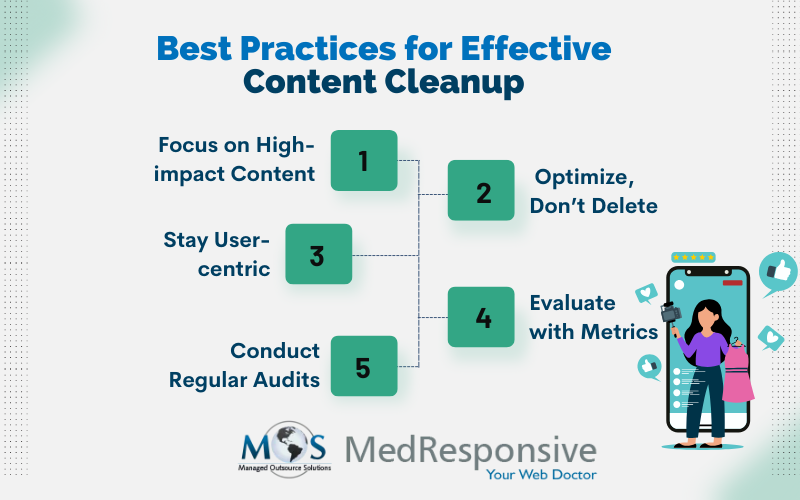Managing a website—in a competitive digital landscape like the present—is a challenging task in itself. From content creation to website navigation and analytics, there are a lot of things to take care of, in order to stay on top of the game. One of the crucial elements that contribute to the success of a website in the digital marketing world is the timely optimization of website content for search engines.
That is when you need to consult a company providing professional content creation services. Effective content optimization, by regularly revisiting and updating the content is essential for enhancing online visibility and driving organic traffic to the website. But, how to ensure what content to keep and what needs to go? This blog will explore how to audit the content, what to delete and the best practices to maintain a robust and SEO-friendly website.
How Often Should Content Be Updated?
Before delving into what to update and delete, let us seek an answer to the lingering question beforehand: how frequently should a content be updated/removed?
- Static Pages: (About us, Resources, Contact): On a quarterly basis.
- Product or Service Page: Frequently or in accordance with addition/launch of a new product/service.
- Blog Posts/Articles: Every six months (depending upon the outdated facts or references or studies).
- SEO-driven Content: Client stories and case studies are known to influence ranking positively and therefore, biannually updating it based on SEO metrics and relevance is necessary.
These guidelines do offer a starting point towards a perfect content optimization strategy, but every website’s requirements vary. For content-heavy websites, frequent updating would be necessary. For a smaller website, annual review or bi-annual review would suffice. Nevertheless, regular cleanup/updating is vital for maintaining a quality website.
What Content Should Be Deleted?
Content cleanups are tedious, but they are essential for engaging search engines and reaching the right audience. However, it is important to assess what content is being deleted as a wrong move can send the website’s rankings into a downward spiral. Some content is worth updating while others need to be gone. Here is a breakdown of the content types that typically need either an updating or deletion:
- Irrelevant Blog Posts: The blog posts that were posted a while ago, should still be relevant to the current target audience and industry. Otherwise, these should be deleted as it could clutter blog archives and dilute brand messaging.
- Outdated Pages: If certain pages (products/services) are not relevant or no longer available, ensure to remove or archive those pages. But if the pages rank well, consider redirecting them to an active, related page to prevent SEO loss.
- Low-quality Content: Low-quality pages with stagnant engagement, low word count can negatively impact the overall SEO experience. Duplicate content can also cause problems as Google penalizes websites. Make sure to draft clear & comprehensive content and remove content/pages that do not contribute to SEO or user engagement.
- Broken Links: Google’s Search Quality Rating Guidelines assess broken links to determine the quality of the website. Ensure there are no broken links as they harm the overall SEO ranking.
How to Delete Website Content
Deleting website content may sound straightforward but it requires a certain amount of planning to avoid taking a hit on the site’s overall SEO performance. Given below is a checklist for deleting content professionally:
- Avoid Mass Deletions: The easy way to get rid of redundant content would be to delete them at once. However, removing large volumes of content at once can affect a website’s SEO ranking. Therefore, prioritize deleting the most irrelevant content, pages and try to spread the deletions periodically, for the best results.
- Optimize Internal Links: Conduct an audit of the website to find internal links that are outdated and/or broken. Ensure all links are updated and make use of tools like Ahrefs to check for dead links to deleted pages.
- 301 Redirects: In case the page that was deleted is still attracting organic visitors, leverage the value of that link by redirecting that URL to a related web page on the site. This will help preserve the SEO value and ensure a better user experience.
- Monitor Performance: Check Google Search Console to track performance, traffic and ensure there are no existing/new issues with the removed contents or fixed links. There may arise a need to remove URLs directly from the index via the Console for quicker action.
Best Practices for Effective Content Cleanup
Here are some of the best practices to adhere to while optimizing website content:
- Work on High-impact Content: Prioritize content based on their SEO performance—analyze and update content that receives most traffic and engagement while low-impact, redundant content/web pages must be queued up for deletion.
- Metric-based Evaluation: Analytics is the most vital tool in content review. Make use of it to generate metrics like, bounce rate, page views, time spent on a page etc. And if there are pages that have high bounce rates or lesser time-on-page, it may need to be reworked or deleted.
- Optimization Instead of Deletion: Not every content or web page needs to be deleted. Always try to optimize the existing content by including refreshing ideas, images or visual improvements which can boost the SEO performance without compromising it with plausible deletion.
- Periodic Content Audits: Perform regular audits to identify redundant contents that may need to be deleted or updated. Using tools like Google Analytics, Ahrefs or Screaming Frog can help understand what’s resonating with the audience.
- Keep a User-centric Mindset: Remember that content cleanup isn’t just for SEO. It is done to improve user experience as well. So, when going for content or web page deletions, keep in mind what users find informative or helpful.
Tools to Streamline the Process
- Google Analytics: The best tool to analyze the website’s performance in search engines.
- Screaming Frog: A tool to audit and identify broken links and duplicate content within the website.
- Ahrefs or SEMrush: Great for keyword research, assessing backlinks and analyzing content performance.
- Grammarly: An online tool for reviewing grammar, spelling, engagement and plagiarism of content.
Content cleanup is not a one-time operation; it is a periodic deed that should become an integral part of your website maintenance. Regardless of the period of maintenance, creating a habit of revisiting and refreshing content helps your website to stay high in SEO rankings and attract organic traffic. Keep in mind that the goal is not to have fewer content, but to have optimized content that equally serves your business goals and visitors.
Therefore, it is ideal to involve an expert in content writing services who can take up the tedious task of professionally analyzing the website end-to-end, and work towards optimizing the content to the industry standard, thereby boosting your website’s reach to the right audience.





